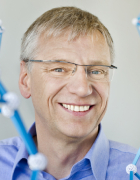
Prof. Dr. Thomas Fässler
Academic Career and Research Areas
Professor Fässler (b. 1959) conducts research on the synthesis, characterization and theoretical description of materials on the basis of inorganic solid matter and molecular compounds. Based on the substance classes of the intermetallic compounds and Zintl phases with soluble Zintl ions his research examines new kinds of main group element-based materials during the transition from molecular compounds to solid matter. The material classes examined in this research have potential in fields such as energy storage materials, energy conversion materials, solar cells, superconductors, and catalysts.
Professor Fässler studied chemistry and mathematics at the University of Konstanz and received his doctorate in chemistry from the University of Heidelberg in 1988. After working as a research fellow at the University of Chicago he acquired his postdoctoral teaching qualification (habilitation) in the field of inorganic chemistry at ETH Zurich in 1999. Before joining TUM as a full professor he held the Chair of Inorganic Chemistry and Solid State Chemistry at TU Darmstadt from 2000 to 2003. Since 2004 Professor Fässler has headed the Advanced Materials Science elite study program, was dean of studies between 2007 and 2010 and has been elected a member of the board of the Wöhler Association for Inorganic Chemistry of the German Society of Chemists (GDCh) and has been its chairman from 2010 to 2014.
Awards
- Arfvedson-Schlenk-Preis, German Chemical Society (2023)
- Member of the Bayerische Akademie der Wissenschaften (2023)
- Rudolf-Hoppe Lectureship, GDCh Division of Solid-State Chemistry & Materials Research (2022)
- Wilhelm-Klemm-Prize, Gesellschaft Deutscher Chemiker (2015)
Key Publications
Boranyl-functionalized [Ge9] Clusters Providing the Idea of Intramolecular Ge/B Frustrated Lewis Pairs. C. Wallach, F. S. Geitner, A. J. Karttunen, T. F. Fässler. Angew. Chem. Int. Ed. 2021, 60, 2648 – 2653. DOI: 10.1002/anie.202012336.
AbstractSynthesis, Structure and Diffusion Pathways of Fast Lithium-Ion Conductors in the Polymorphs α- and β-Li8SnP4. S. Strangmüller, H. Eickhoff, W. Klein, G. Raudaschl-Sieber, H. Kirchhain, T. Kutsch, V. Baran, A. Senyshyn, L. van Wüllen, H. A. Gasteiger, T. F. Fässler. J. Mat. Chem. A, 2021, 9, 15254–15268. DOI: 10.1002/anie.201914613.
AbstractFast Lithium Ion Conduction in Lithium Phosphidoaluminates. T. M. F. Restle, Ch. Sedlmeier, H. Kirchhain, W. Klein, G. Raudaschl-Sieber, V. L. Deringer, L. van Wüllen, H. A. Gasteiger, T. F. Fässler. Angew. Chem. Int. Ed. 2020, 59, 5665 – 5674. DOI: 10.1002/anie.201914613.
AbstractFast Ionic Conductivity in the most Lithium-Rich Phosphidosilicate Li14SiP6. S. Strangmüller, H. Eickhoff, D. Müller, W. Klein, G. Raudaschl-Sieber, H. Kirchhain, Ch. Sedlmeier, V. Baran, A. Senyshyn, V. L. Deringer, L. van Wüllen, H. A. Gasteiger, Thomas F. Fässler. J Am. Chem Soc. 2019, 141, 14200−14209. DOI: 10.1021/jacs.9b05301
AbstractStegmaier S, Fässler TF: “A Bronze Matryoshka – The Discrete Intermetalloid Cluster [Sn@Cu12@Sn20]12− in the Ternary Phases A12Cu12Sn21 (A = Na, K)”. J. Am. Chem. Soc. 2011, 133, 19758-19768. DOI: 10.1021/ja205934p
AbstractIf you wish your profile to be changed or updated please contact Franz Langer.